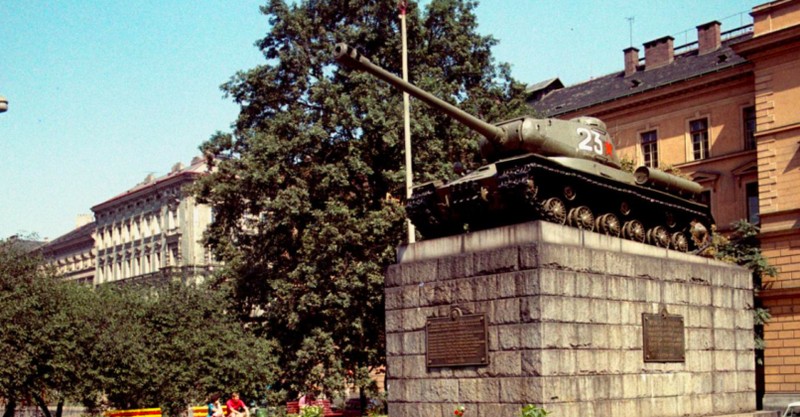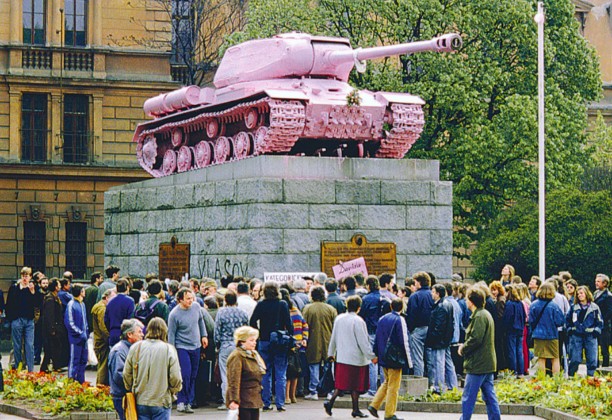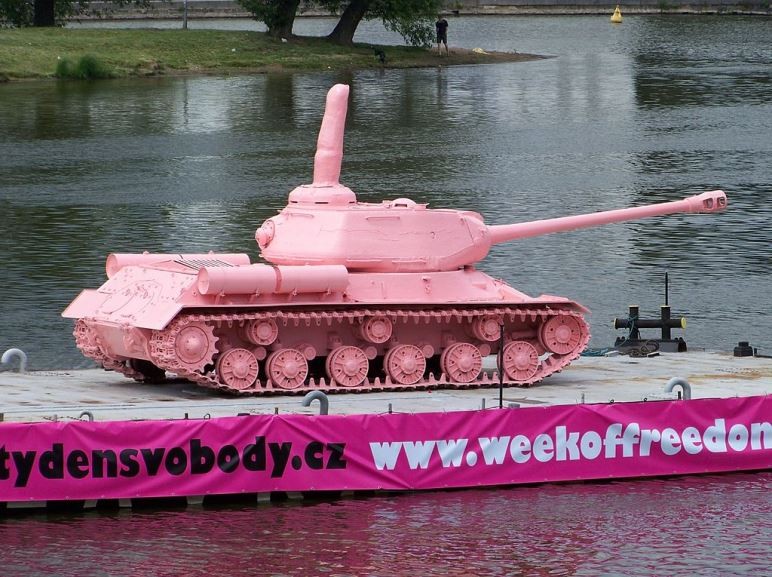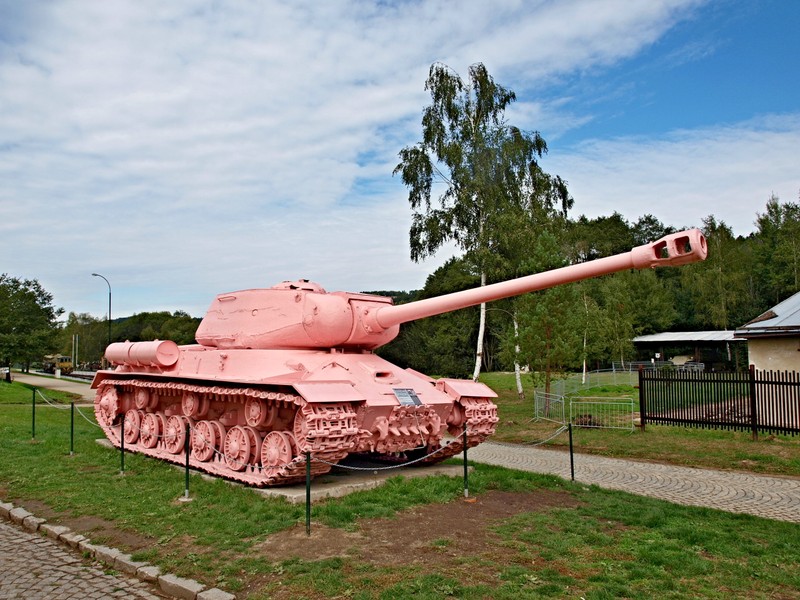Pink Tank
Introduction
Text-to-speech Audio
On April 28, 1991, residents of Prague woke up to the tank on top of the Monument to Soviet Tank Crews painted a striking, rebellious pink color. Originally made to honor fallen Soviet tank crews of WWII, the monument was placed in Kinsky Square, Prague, and painted in traditional shades of military green for 46 years, until a group of students led by David Černý gave the tank a new pink style in an act of self-declared civil disobedience. The monument had faded into the background by 1991, but this fresh coat of pink paint reminded people of the memories attached to the tank. Soviet officials and members of the Czech government waged an unofficial battle centered around the color of the tank, painting it pink to green and back again, until the tank was retired to a military museum south of Prague. This, along with some ironic timing related to the number 23 that was originally painted on the tank, has made the monument a fascinating indicator throughout the years of how opinions about the USSR, Czech government, and even somewhat the Nazis has changed. (The video below shows the 1945 installation of the tank on top of the monument, and the location of Kinsky Square has been pinned.)
Images
The Original Tank Before Being Painted, 1946

The Tank After Being Painted Pink, 1991

The Pink Tank in Prague with Middle Finger, 2011

The Pink Tank at Military Museum Lešany, 2012

Backstory and Context
Text-to-speech Audio
During the final months of WWII, Allies armies worked to liberate countries that had fallen under Nazi control. Czechoslovakia was liberated by Soviet troops from the east, who headed to the capital city of Prague, and US troops from the west, who headed to the industrial city of Pilsen. In May of 1945, Soviet tanks entered Prague and officially liberated it, prompting the building of the Monument to Soviet Tank Crews in Kinsky Square on July 29 of 1945, meant to honor the men who lost their lives in the fight to get to Prague. Supposedly the first tank to enter Prague was placed on top of a pedestal to create the monument, although the displayed tank type and possibly even number was incorrect, and no one is sure of what happened to the original tank. The original tank was a T34 cruiser tank, or fast tank, or medium tank, a tank suited to quick movement while still being mass produced, having thousands of identical copies across the battlefield. The displayed tank was an IS2, more of a heavy tank, and the number 23 was painted on it. The original tank number was one of three in a formation that advanced into Prague, either 23, 24, or 25, although most debate is between whether it was 23 or 24.
In 1948, a communist coup put Czechoslovakia under the control of the USSR, and the monument was given the official designation of National Cultural Monument. It stood in decent public opinion in Kinsky Square for the next 20 years, until the Warsaw Pact invasion in 1968. The Warsaw Pact invasion was led by the Soviet Union, and combined the armies of the Soviet Union, Bulgaria, Hungary and Poland in order to invade Czechoslovakia. The Warsaw Pact invasion was the Soviet Union’s attempt to crush Prague Spring reform ideas of additional human rights for Czech and Slovak citizens, as well as the idea of socialism with a human face. This action resulted in 58 civilian casualties on the first day of the invasion alone, including the death of an eight year old girl. This understandably soured opinions towards the Soviet Union, and a tank meant to represent the Soviet men who gave their lives in the liberation of Prague became a cruel reminder of that generation’s sons and their actions. Suddenly the tank represented the constant observation and control of the USSR, especially after the staying of Soviet units got legalized by signing a pact on their presence in the country, making a temporary occupation last 23 years. This made the number 23 painted on the monument seem very ironic, especially since the Warsaw Pact invasion also happened 23 years after the dedication of the monument.
Coincidentally, another 23 years later on April 27, 1991, in an act of self-declared civil disobedience, a group of students led by David Černý painted the tank pink during the night. This came two years after the 1989 Velvet Revolution in Czechoslovakia, a bloodless revolution that overthrew the communist government in power. David Černý was arrested for hooliganism, and Soviet authorities, who still had troops in Czechoslovakia, protested about this change until it was painted its original green again only three days later, on April 30. On May 10, only ten days after the tank had been painted green again, members of the newly elected parliaments from Public Against Violence and Civic Forum used their official immunity and painted the tank back to pink as a sign of a protest against David Černý's arrest. Over the next few months, it was painted green again, then pink, and this cycle continued until it was moved to Military Museum Lešany, south of Prague, where it still stands today, painted pink. It briefly returned to Prague in 2011, anchored on a pontoon in the middle of the Vltava river near Střelecký Island. A large pink middle finger, made by David Černý, was also added to the top of the tank during its stay in Prague. Soon after, the tank was retired to Military Museum Lešany again, gaining its final definitive layer of pink paint. There have been some efforts to repaint it green, in memory of the original 1945 tank crews, but none have really gained much traction. Currently, the spot formerly occupied by the monument is home to a fountain called the Trapdoor of Time, which was installed in October of 2002. Another monument, a half buried tank, also currently stands in Kinsky Square, called Tank Torso and is painted in blue and yellow to support Ukraine as of March 2022.
Sources
Davis, Jenelle. “Marking Memory: Ambiguity and Amnesia in the Monument to Soviet Tank Crews in Prague.” Public Art Dialogue, vol. 6, no. 1, 2016, pp. 35–57.
On this Day, in 1991: Czech artist David Černý famously painted Soviet tank No. 23 in pink, Kafkadesk. April 27th, 2022. https://kafkadesk.org/2022/04/27/on-this-day-in-1991-czech-artist-david-cerny-famously-painted-soviet-tank-no-23-in-pink/.
Pink Tank (David Černý) & Trapdoor of Time (Jan Lauda) — Our Beautiful Prague, Our Beautiful Prague. April 15th, 2021. https://www.ourbeautifulprague.com/pink-tank-david-cerny-trapdoor-of-time-jan-lauda/.
Takac, Balasz. When David Černý Made a Tank Monument Interesting, Widewalls. May 6th, 2020. https://www.widewalls.ch/magazine/monument-to-soviet-tank-crews-david-cerny.
“Warsaw Pact Invasion Crushes Prague Spring Reform Attempt in 1968.” Daily News (Prague, Czech Republic), 2019, pp. Daily News (Prague, Czech Republic), 2019.
https://ct24.ceskatelevize.cz/
https://www.idnes.cz/
https://www.widewalls.ch/
https://commons.wikimedia.org/wiki/File:Le%C5%A1any_tank_1.jpg
